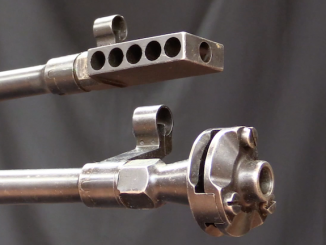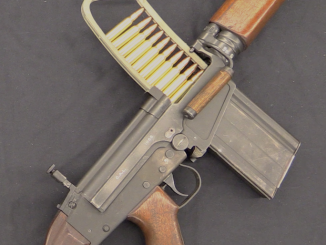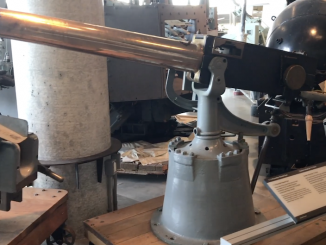In August 1913, the British War Office wrote to Sir Charles Ross requesting a sample automatic rifle for trials in the UK. Ross was able to submit a prototype on May 1914, which was tested at Enfield – but only fired 308 rounds before the test ended, suggesting that something important probably broke. The gun was a very strange looking contraption, whose Ross MkIII lineage is visible only in the bolt and front of the receiver forging. A long stroke gas pistol was added, and the action flipped upside-down. A large 25-round magazine was fitted, along with a thumbhole style stock that looks very similar to the grip of a Lewis gun. In addition to one example tested at Enfield in .303 caliber, one other model was send to the US for testing, chambered for .30-06. That is the gun we are looking at today, which came to the Canadian War Museum from the collection stored at Fort Knox in the 197-s and 80s.
Thanks to the Canadian War Museum for providing me access to film this extremely unusual Ross for you!




A few notes.
1. The receiver cover/magazine well setup is only held in place by the two “hourglass-shaped” clamps on the sides. Undo their screws and the entire thing lifts straight up and off.
2. The knurled ring at the front end of the gas piston tube might just be for takedown purposes. Then again, it might be a gas-port adjustment.
3. The sliding “button” above the trigger on the left side is most likely a sear-blocking safety. Whichever way this one worked, it was either semi-auto or full-auto, not selective fire.
4. If full-auto, with the combination of gas operation and the lightweight Ross bolt, that buffer would be needed to prevent a nearly uncontrollably-high rate of fire. As it is, I’d expect a RoF around 750 R/M.
Put it all together, and I suspect this was not intended as a self-loading rifle, but more likely as a light machine gun. Considering the time frame (1917 vs. 1913-14) and the provenance (U.S. Army Ordnance), I’ll venture to say that this was very likely a prototype flexible aircraft gun for two-seater observation and bombing planes.
Just a guess.
cheers
eon
Magazine-fed light machine guns in airplanes made sense at the time. Try replacing a cloth feed belt when everything’s gone turbulent. It isn’t easy when someone else is trying to kill you in the sky, and it’s more difficult than slamming a detachable magazine into the receiver well. I could be wrong.
You are correct.
I recall as an early teen, reading in Biggle’s adventures https://en.wikipedia.org/wiki/Biggles
that ammo belt’s lack of cooperation at low temps caused lots of grief to combat pilots. As a result, for that reason more than any other, they had plenty of opportunity to put their chivalry on display.
With mag-fed guns, typically operated by observers, there was less chance for that kind of virtue.
I must have one. This is the only rifle even half as good as a chauchat.
That would explain the holes in the mag as by 1917 you would have thought that trench warfare had proved holes in any part of a weapon would clog with mud
When going up into the air, you need to shave away dead weight.
The joints Ian calls mortice and tendon are actually Dovetail’s. They hold using the double mating angle like a doves tail… very common in building fine furniture draws. A mortice is a square or rectangular slot cut with a mating insert held together with a tapered tenon thru a common drilled hole. In all wood construction the material for the mortice must not be the same as the tenon. For they would work loose as they dry or expand with humidity at the same rate.
A straight pull bolt action rifle is always one step from a semi-auto or full auto rifle.
Why doesn’t some enterprising firearms company sponsor Ian von GunWazUs to do an accredited course and supply him with gauges to perform measurements in the field….even if it is just field go-nogo gauges. Rather than guess, and leave us all wondering…
I’m not quite sure why Ian couldn’t determine if this was FA or semi? A rather simple functions test would tell you what mode it’s in or am I missing something?
If some parts are missing, it could not be so easy to figure it out
The fact that the hammer “follows down” when the bolt goes into battery could indicate full-auto fire. As could the fact that it fires from an open bolt.
Then again, it could indicate a damaged sear or missing or damaged disconnector on a semi-auto action.
I’m inclined to think it’s full-auto (see above) but as stated, that’s just a guess. To be sure, I’d have to take it apart.
cheers
eon
I saw a patent for this thing.
Perhaps I can find it again.
Visited the Patton Museum a couple of years ago. Seemed to only have on display items reasonably connected to General Patton.
A good Museum and worth visiting, but prototypes like this one would have been a bit out of place there.
They are indeed dovetails not mortise and tenon. However tenons are usually NOT tapered as this would ensure a somewhat loose fit. Also the idea that a mortice and tenon imust be of different woods is wrong. They CAN be of different woods but almost always they belong to the same species. One WANTS the two separate pieces to move at the same rate. I’ve built many an item with this type of joinery as it has been my profession for almost 30 years.
Looking at the two Historic photographs as far as I can tell the action has not been turned upside down but undergone a fundamental modification. The Gas piston and Barrel has been turned on its side so that the gas piston is on the left side of the barrel. The charging handle is still on the right side of the action and the magazine is now underneath.
Now whether there was a second prototype as shown in the photographs or the existing gun is the pictured one subsequently modified is anyone’s guess.